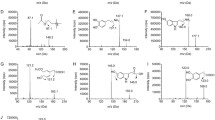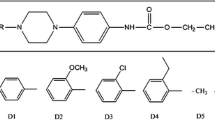Abstract
Alzheimer's disease (AD) is a progressive, chronic and age-related neurodegenerative disorder that affects millions of people across the world. In pursuit of new anti-AD remedies, 2-[Hydroxy-(4-nitrophenyl)methyl]-cyclopentanone (NMC), a β hydroxyl ketone derivative was studied to explore its neuroprotective potentials against AD. The in-vitro AChE and BuChE enzymes inhibition were evaluated by Ellman protocol and antioxidant potentials of NMC by DPPH free radical scavenging assay. In-vivo behavioral studies were performed in the transgenic 5xFAD mice model of AD using shallow water maze (SWM), Paddling Y-Maze (PYM), elevated plus maze (EPM) and balance beam (BB) tests. Also, the ex-vivo cholinesterase inhibitory effects of NMC and histopathological analysis of amyloid-β plaques were determined in the frontal cortex and hippocampal regions of the mice brain. NMC exhibited significant in vitro anti-cholinesterase enzyme potentials with an IC50 value of 67 μg/ml against AChE and 96 μg/ml against BuChE respectively. Interestingly, the activities of AChE and BuChE enzymes were also significantly lower in the cortex and hippocampus of NMC-treated groups. Also, in the DPPH assessment, NMC displayed substantial antioxidant properties with an IC50 value observed as 171 μg/ml. Moreover, histopathological analysis via thioflavin-s staining displayed significantly lower plaques depositions in the cortex and hippocampus region of NMC-treated mice groups. Furthermore, SWM, PYM, EPM, and BB behavioral analysis indicated that NMC enhanced spatial learning, memory consolidation and improved balance performance. Altogether, to the best of our knowledge, we believe that NMC may serve as a potential and promising anti-cholinesterase, antioxidant and neuroprotective agent against AD.




Similar content being viewed by others
Abbreviations
- AD:
-
Alzheimer disease
- NMC:
-
2-[Hydroxy-(4-nitrophenyl)methyl]-cyclopentanone
- SWM:
-
Shallow water maze
- PYM:
-
Paddling Y-maze
- AChE:
-
Acetylcholinesterase enzyme
- BuChE:
-
Butrylcholinesterase enzyme
- CNS:
-
Central nervous system
- DTNB:
-
2,2 Dithiobisnitrobenzoic acid
References
Cummings JL, Cole G (2002) Alzheimer disease. JAMA 287(18):2335–2338. https://doi.org/10.1001/jama.287.18.2335
Brookmeyer R, Johnson E, Ziegler-Graham K, Arrighi HM (2007) Forecasting the global burden of Alzheimer’s disease. Alzheimer’s Dementia 3(3):186–191. https://doi.org/10.1016/j.jalz.2007.04.381
LaFerla FM, Oddo S (2005) Alzheimer’s disease: Aβ, tau and synaptic dysfunction. Trends Mol Med 11(4):170–176. https://doi.org/10.1016/j.molmed.2005.02.009
Heppner FL, Ransohoff RM, Becher B (2015) Immune attack: the role of inflammation in Alzheimer disease. Nat Rev Neurosci 16(6):358. https://doi.org/10.1038/nrn3880
Hamos JE, DeGennaro LJ, Drachman DA (1989) Synaptic loss in Alzheimer’s disease and other dementias. Neurology 39(3):355–355. https://doi.org/10.1212/wnl.39.3.355
Sanabria-Castro A, Alvarado-Echeverría I, Monge-Bonilla C (2017) Molecular pathogenesis of Alzheimer’s disease: an update. Ann Neurosci 24(1):46–54. https://doi.org/10.1159/000464422
Kumar A, Singh A (2015) A review on Alzheimer’s disease pathophysiology and its management: an update. Pharmacol Rep 67(2):195–203. https://doi.org/10.1016/j.pharep.2014.09.004
Holzgrabe U, Kapková P, Alptüzün V, Scheiber J, Kugelmann E (2007) Targeting acetylcholinesterase to treat neurodegeneration. Expert Opin Ther Targets 11(2):161–179. https://doi.org/10.1517/14728222.11.2.161
Muhammad T, Ali T, Ikram M, Khan A, Alam SI, Kim MO (2019) Melatonin rescue oxidative stress-mediated neuroinflammation/neurodegeneration and memory impairment in scopolamine-induced amnesia mice model. J Neuroimmune Pharmacol 14(2):278–294. https://doi.org/10.1007/s11481-018-9824-3
Khan A, Ikram M, Muhammad T, Park J, Kim MO (2019) Caffeine modulates cadmium-induced oxidative stress, neuroinflammation, and cognitive impairments by regulating Nrf-2/HO-1 in vivo and in vitro. J Clin Med 8(5):680. https://doi.org/10.3390/jcm8050680
Schelterns P, Feldman H (2003) Treatment of Alzheimer’s disease; current status and new perspectives. Lancet Neurol 2(9):539–547. https://doi.org/10.1016/s1474-4422(03)00502-7
Reisberg B, Doody R, Stöffler A, Schmitt F, Ferris S, Möbius HJ (2003) Memantine in moderate-to-severe Alzheimer’s disease. N Engl J Med 348(14):1333–1341. https://doi.org/10.1056/NEJMoa013128
Danysz W, Parsons CG (2003) The NMDA receptor antagonist memantine as a symptomatological and neuroprotective treatment for Alzheimer’s disease: preclinical evidence. Int J Geriatric Psychiatry 18(S1):S23–S32. https://doi.org/10.1002/gps.938
Huang Y, Mucke L (2012) Alzheimer mechanisms and therapeutic strategies. Cell 148(6):1204–1222. https://doi.org/10.1016/j.cell.2012.02.040
Mangialasche F, Solomon A, Winblad B, Mecocci P, Kivipelto M (2010) Alzheimer’s disease: clinical trials and drug development. Lancet Neurol 9(7):702–716. https://doi.org/10.1016/S1474-4422(10)70119-8
Trost BM, Brindle CS (2010) The direct catalytic asymmetric aldol reaction. Chem Soc Rev 39(5):1600–1632. https://doi.org/10.1039/B923537J
Padrón JM, Miranda PO, Padrón JI, Martín VS (2006) β′-Hydroxy-α, β-unsaturated ketones: a new pharmacophore for the design of anticancer drugs. Bioorg Med Chem Lett 16(8):2266–2269. https://doi.org/10.1021/jo048410j
Mandal S, Mandal S, Ghosh SK, Ghosh A, Saha R, Banerjee S, Saha B (2016) Review of the aldol reaction. Synth Commun 46(16):1327–1342. https://doi.org/10.1080/00397911.2016.1206938
Kurata T, Miyazaki K, Kozuki M, Morimoto N, Ohta Y, Ikeda Y, Abe K (2012) Atorvastatin and pitavastatin reduce senile plaques and inflammatory responses in a mouse model of Alzheimer’s disease. Neurol Res 34(6):601–610. https://doi.org/10.1179/1743132812Y.0000000054
Ayaz M, Junaid M, Ullah F, Subhan F, Sadiq A, Ali G, Ovais M, Shahid M, Ahmad A, Wadood A (2017) Anti-Alzheimer’s studies on β-sitosterol isolated from Polygonum hydropiper L. Front Pharmacol 8:697. https://doi.org/10.3389/fphar.2017.00697
Ellman GL, Courtney KD, Andres V Jr, Featherstone RM (1961) A new and rapid colorimetric determination of acetylcholinesterase activity. Biochem Pharmacol 7(2):88–95. https://doi.org/10.1016/0006-2952(61)90145-9
Kamal Z, Ullah F, Ayaz M, Sadiq A, Ahmad S, Zeb A, Hussain A, Imran M (2015) Anticholinesterse and antioxidant investigations of crude extracts, subsequent fractions, saponins and flavonoids of Atriplex laciniata L.: potential effectiveness in Alzheimer’s and other neurological disorders. Biol Res 48(1):21. https://doi.org/10.1186/s40659-015-0011-1
Brasford M (1976) A rapid and sensitive method for quantitation of microgram quantities of protein utilizing the principle of protein-dye binding. Anal Biochem 72:248–254. https://doi.org/10.1016/0003-2697(76)90527-3
Braca A, De Tommasi N, Di Bari L, Pizza C, Politi M, Morelli I (2001) Antioxidant principles from bauhinia t arapotensis. J Nat Prod 64(7):892–895. https://doi.org/10.1021/np0100845
Petrasek T, Prokopova I, Bahnik S, Schonig K, Berger S, Vales K, Tews B, Schwab ME, Bartsch D, Stuchlik A (2014) Nogo-A downregulation impairs place avoidance in the Carousel maze but not spatial memory in the Morris water maze. Neurobiol Learn Mem 107:42–49. https://doi.org/10.1016/j.nlm.2013.10.015
Deacon RM (2013) Shallow water (paddling) variants of water maze tests in mice. J Vis Exp 76:e2608. https://doi.org/10.3791/2608
Kulkarni PD, Ghaisas MM, Chivate ND, Sankpal PS (2011) Memory enhancing activity of Cissampelos pariera in mice. Int J Pharm Pharm Sci 3(2):206–211
Shahid M, Subhan F, Ali G, Ullah I, Alam J, Ullah S, Rauf K (2017) Neuroprotective effect of Bacopa monnieri against morphine-induced histopathological changes in the cerebellum of rats. Pakistan J Pharm Sci 30(6):2067–2074
Ly PT, Cai F, Song W (2011) Detection of neuritic plaques in Alzheimer’s disease mouse model. J Vis Exp 53:e2831. https://doi.org/10.3791/2831
Calderon F, Von Bernhardi R, De Ferrari G, Luza S, Aldunate R, Inestrosa N (1998) Toxic effects of acetylcholinesterase on neuronal and glial-like cells in vitro. Mol Psychiatry 3(3):247–255. https://doi.org/10.1038/sj.mp.4000383
Francis PT, Palmer AM, Snape M, Wilcock GK (1999) The cholinergic hypothesis of Alzheimer’s disease: a review of progress. J Neurol Neurosurg Psychiatry 66(2):137–147. https://doi.org/10.1136/jnnp.66.2.137
Ballard C (2002) Advances in the treatment of Alzheimer’s disease: benefits of dual cholinesterase inhibition. Eur Neurol 47(1):64–70. https://doi.org/10.1159/000047952
Whitehouse PJ, Price DL, Struble RG, Clark AW, Coyle JT, Delon MR (1982) Alzheimer’s disease and senile dementia: loss of neurons in the basal forebrain. Science 215(4537):1237–1239. https://doi.org/10.1126/science.7058341
Dunn N, Pearce G, Shakir S (2000) Adverse effects associated with the use of donepezil in general practice in England. J Psychopharmacol 14(4):406–408. https://doi.org/10.1177/026988110001400410
Takada-Takatori Y, Kume T, Sugimoto M, Katsuki H, Sugimoto H, Akaike A (2006) Acetylcholinesterase inhibitors used in treatment of Alzheimer’s disease prevent glutamate neurotoxicity via nicotinic acetylcholine receptors and phosphatidylinositol 3-kinase cascade. Neuropharmacology 51(3):474–486. https://doi.org/10.1016/j.neuropharm.2006.04.007
Muhammad T, Ikram M, Ullah R, Rehman SU, Kim MO (2019) Hesperetin, a citrus flavonoid, attenuates LPS-induced neuroinflammation, apoptosis and memory impairments by modulating TLR4/NF-κB signaling. Nutrients 11(3):648. https://doi.org/10.3390/nu11030648
Khan A, Ali T, Rehman SU, Khan MS, Alam SI, Ikram M, Muhammad T, Saeed K, Badshah H, Kim MO (2018) Neuroprotective effect of quercetin against the detrimental effects of LPS in the adult mouse brain. Front Pharmacol 9:1383. https://doi.org/10.3389/fphar.2018.01383
Ikram M, Saeed K, Khan A, Muhammad T, Khan MS, Jo MG, Rehman SU, Kim MO (2019) Natural dietary supplementation of curcumin protects mice brains against ethanol-induced oxidative stress-mediated neurodegeneration and memory impairment via Nrf2/TLR4/RAGE signaling. Nutrients 11(5):1082. https://doi.org/10.3390/nu11051082
Khan MS, Muhammad T, Ikram M, Kim MO (2019) Dietary supplementation of the antioxidant curcumin halts systemic LPS-induced neuroinflammation-associated neurodegeneration and memory/synaptic impairment via the JNK/NF-kappaB/Akt signaling pathway in adult rats. Oxid Med Cell Longev 2019:7860650. https://doi.org/10.1155/2019/7860650
Jiang T, Sun Q, Chen S (2016) Oxidative stress: a major pathogenesis and potential therapeutic target of antioxidative agents in Parkinson’s disease and Alzheimer’s disease. Prog Neurobiol 147:1–19. https://doi.org/10.1016/j.pneurobio.2016.07.005
Smith MA, Rottkamp CA, Nunomura A, Raina AK, Perry G (2000) Oxidative stress in Alzheimer’s disease. Biochimica et Biophysica Acta (BBA) 1502(1):139–144. https://doi.org/10.1016/s0925-4439(00)00040-5
Su B, Wang X, Lee H-g, Tabaton M, Perry G, Smith MA, Zhu X (2010) Chronic oxidative stress causes increased tau phosphorylation in M17 neuroblastoma cells. Neurosci Lett 468(3):267–271. https://doi.org/10.1016/j.neulet.2009.11.010
Hardy J, Selkoe DJ (2002) The amyloid hypothesis of Alzheimer’s disease: progress and problems on the road to therapeutics. Science 297(5580):353–356. https://doi.org/10.1126/science.1072994
Hardy JA, Higgins GA (1992) Alzheimer’s disease: the amyloid cascade hypothesis. Science 256(5054):184–186. https://doi.org/10.1126/science.1566067
Näslund J, Haroutunian V, Mohs R, Davis KL, Davies P, Greengard P, Buxbaum JD (2000) Correlation between elevated levels of amyloid β-peptide in the brain and cognitive decline. JAMA 283(12):1571–1577. https://doi.org/10.1001/jama.283.12.1571
Chen G, Chen KS, Knox J, Inglis J, Bernard A, Martin SJ, Justice A, McConlogue L, Games D, Freedman SB (2000) A learning deficit related to age and β-amyloid plaques in a mouse model of Alzheimer’s disease. Nature 408(6815):975. https://doi.org/10.1023/A:1023255106106
Arendt T, Bigl V, Tennstedt A, Arendt A (1985) Neuronal loss in different parts of the nucleus basalis is related to neuritic plaque formation in cortical target areas in Alzheimer’s disease. Neuroscience 14(1):1–14. https://doi.org/10.1016/0306-4522(85)90160-5
Khan M, Ullah R, Rehman SU, Shah SA, Saeed K, Muhammad T, Park HY, Jo MH, Choe K, Rutten BPF, Kim MO (2019) 17beta-estradiol modulates SIRT1 and halts oxidative stress-mediated cognitive impairment in a male aging mouse model. Cells 8(8):928. https://doi.org/10.3390/cells8080928
D’Hooge R, De Deyn PP (2001) Applications of the Morris water maze in the study of learning and memory. Brain Res Rev 36(1):60–90. https://doi.org/10.1016/s0165-0173(01)00067-4
Morris JC, Rubin EH, Morris EJ, Mandel SA (1987) Senile dementia of the Alzheimer’s type: an important risk factor for serious falls. J Gerontol 42(4):412–417. https://doi.org/10.1093/geronj/42.4.412
Funding
We acknowledge the funding (National research program for universities; NRPU 6671/KP/NRPU/R&D/HEC/2016) from Higher education commission of Pakistan for the completion of necessary part of the project. The funding authorities did not contribute to the plan, design or any other part of the research work.
Author information
Authors and Affiliations
Contributions
SIA performed and carried out all experimental work, data collection and evaluation, and wrote a preliminary draft of the manuscript. GA conceived, designed and supervised the study. Also, he edited and reviewed the final version of the manuscript. RU helped in performing genotyping studies. TM helped in data analysis and drafted the final version of the manuscript. NU synthesized and structurally confirmed the NMC compound (chemistry data published ‘Picolylamine as an Organocatalyst Template for highly Diastero-And Enantioselective Aqueous Aldol Reactions’. ANH helped us in the behavioral studies and edited and reviewed the final draft of the manuscript. All authors reviewed and approved the final version of the manuscript.
Corresponding authors
Ethics declarations
Conflict of interest
The authors declare no conflict of interest.
Ethical approval
This research was carried out under the project title as Novel targeted heterocyclic compounds, a potential candidate for Alzheimer's disease’ approved by the Research Ethical Committee of Pharmacy Department, University of Peshawar, Pakistan has been approved all experimental procedures on animals vide reference number 25/EC-18/Pharm, dated. 16/10/2018.
Additional information
Publisher's Note
Springer Nature remains neutral with regard to jurisdictional claims in published maps and institutional affiliations.
Electronic supplementary material
Below is the link to the electronic supplementary material.
Rights and permissions
About this article
Cite this article
Ahmad, S.I., Ali, G., Muhammad, T. et al. Synthetic β-hydroxy ketone derivative inhibits cholinesterases, rescues oxidative stress and ameliorates cognitive deficits in 5XFAD mice model of AD. Mol Biol Rep 47, 9553–9566 (2020). https://doi.org/10.1007/s11033-020-05997-0
Received:
Accepted:
Published:
Issue Date:
DOI: https://doi.org/10.1007/s11033-020-05997-0




